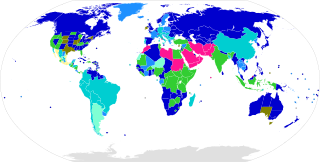
The age of consent is the age at which a person is considered to be legally competent to consent to sexual acts. Consequently, an adult who engages in sexual activity with a person younger than the age of consent is unable to legally claim that the sexual activity was consensual, and such sexual activity may be considered child sexual abuse or statutory rape. The person below the minimum age is considered the victim, and their sex partner the offender, although some jurisdictions provide exceptions through "Romeo and Juliet laws" if one or both participants are underage and are close in age.

A victimless crime is an illegal act that typically either directly involves only the perpetrator or occurs between consenting adults. Because it is consensual in nature, whether there involves a victim is a matter of debate. Definitions of victimless crimes vary in different parts of the world and different law systems, but usually include possession of any illegal contraband, recreational drug use, prostitution and prohibited sexual behavior between consenting adults, assisted suicide, and smuggling among other similar infractions.

Pornographic films (pornos), erotic films, sex films, 18+ films, or also known as blue movie or blue film, are films that present sexually explicit subject matter in order to arouse, fascinate, or satisfy the viewer. Pornographic films present sexual fantasies and usually include erotically stimulating material such as nudity (softcore) and sexual intercourse (hardcore). A distinction is sometimes made between "erotic" and "pornographic" films on the basis that the latter category contains more explicit sexuality, and focuses more on arousal than storytelling; the distinction is highly subjective.

Hardcore pornography or hardcore porn is pornography that features detailed depictions of sexual organs or sexual acts such as vaginal, anal, oral or manual intercourse, ejaculation, and fetish play. The term is in contrast with less-explicit softcore pornography. Hardcore pornography usually takes the form of photographs, films, and cartoons. Since the mid-1990s, hardcore pornography has become widely available on the internet, making it more accessible than ever before.

Pornography laws by region vary throughout the world. The production and distribution of pornographic films are both activities that are legal in some but not all countries, as long as the pornography features performers aged above a certain age, usually 18 years. Further restrictions are often placed on such material.

Pornography has been dominated by a few pan-European producers and distributors, the most notable of which is the Private Media Group that successfully claimed the position previously held by Color Climax Corporation in the early 1990s. Most European countries also have local pornography producers, from Portugal to Serbia, who face varying levels of competition with international producers. The legal status of pornography varies widely in Europe; its production and distribution are illegal in countries such as Ukraine, Belarus and Bulgaria, while Hungary has liberal pornography laws.
The history of zoophilia and bestiality begins in the prehistoric era, where depictions of humans and non-human animals in a sexual context appear infrequently in European rock art. Bestiality remained a theme in mythology and folklore through the classical period and into the Middle Ages and several ancient authors purported to document it as a regular, accepted practice—albeit usually in "other" cultures.
Ministry of Justice of Denmark is the Danish government ministry responsible for the general judicial system, including the police and the prosecution service, the courts of law, and prisons and the probation service. In addition, the Ministry is responsible for legislation in the areas of criminal, private and family law, the law of trusts and foundations, nationality law and data protection law. The Ministry of Justice of Denmark might oversee the administration of justice in Greenland.
The ages of consent vary by jurisdiction across Europe. The ages of consent – hereby meaning the age from which one is deemed able to consent to having sex with anyone else of consenting age or above – are between 14 and 18. The vast majority of countries set their ages in the range of 14 to 16; only four countries, Cyprus (17), Ireland (17), Turkey (18), and the Vatican City (18), set an age of consent higher than 16.
Zoophilia is a paraphilia in which a person experiences a sexual fixation on non-human animals. Bestiality instead refers to cross-species sexual activity between humans and non-human animals. Because of the lack of research on the subject, it is difficult to conclude how prevalent bestiality is. Zoophilia on the other hand, was estimated in one study that to be prevalent in 2% of the population in 2021.

Berl Kutchinsky was a Danish Professor of Criminology at the University of Copenhagen. He became internationally famous for his studies in the public health effects of pornography.
In common law jurisdictions, statutory rape is nonforcible sexual activity in which one of the individuals is below the age of consent. Although it usually refers to adults engaging in sexual contact with minors under the age of consent, it is a generic term, and very few jurisdictions use the actual term statutory rape in the language of statutes. In statutory rape, overt force or threat is usually not present. Statutory rape laws presume coercion because a minor or mentally disabled adult is legally incapable of giving consent to the act.

A sodomy law is a law that defines certain sexual acts as crimes. The precise sexual acts meant by the term sodomy are rarely spelled out in the law, but are typically understood and defined by many courts and jurisdictions to include any or all forms of sexual acts that are deemed to be "illegal", "illicit", "unlawful", "unnatural" and/or "immoral". Sodomy typically includes anal sex, oral sex, manual sex, and bestiality. In practice, sodomy laws have rarely been enforced to target against sexual activities between individuals of the opposite sex, and have mostly been used to target against sexual activities between individuals of the same sex.
Legal frameworks around fictional pornography depicting minors vary depending on country and nature of the material involved. Laws against production, distribution and consumption of child pornography generally separate images into three categories: real, pseudo, and virtual. Pseudo-photographic child pornography is produced by digitally manipulating non-sexual images of real minors to make pornographic material. Virtual child pornography depicts purely fictional characters. "Fictional pornography depicting minors", as covered in this article, includes these latter two categories, whose legalities vary by jurisdiction, and often differ with each other and with the legality of real child pornography.

In the United States, child pornography is illegal under federal law and in all states and is punishable by up to life imprisonment and fines of up to $250,000. U.S. laws regarding child pornography are virtually always enforced and amongst the harshest in the world. The Supreme Court of the United States has found child pornography to be outside the protections of the First Amendment to the United States Constitution. Federal sentencing guidelines on child pornography differentiate between production, distribution, and purchasing/receiving, and also include variations in severity based on the age of the child involved in the materials, with significant increases in penalties when the offense involves a prepubescent child or a child under the age of 18. U.S. law distinguishes between pornographic images of an actual minor, realistic images that are not of an actual minor, and non-realistic images such as drawings. The latter two categories are legally protected unless found to be obscene, whereas the first does not require a finding of obscenity.
Child pornography is erotic material that depicts persons under the age of 18. The precise characteristics of what constitutes child pornography varies by criminal jurisdiction.

Prostitution laws varies widely from country to country, and between jurisdictions within a country. At one extreme, prostitution or sex work is legal in some places and regarded as a profession, while at the other extreme, it is considered a severe crime punishable by death in some other places. A variety of different legal models exist around the world, including total bans, bans that only target the customer, and laws permitting prostitution but prohibiting organized groups, an example being brothels.
The following outline is provided as an overview of and topical guide to human sexuality:
Phyllis and Eberhard Kronhausen were a husband-and-wife team of American sexologists, mainly active in the 1960s and 1970s. They wrote a number of books on sexuality and eroticism, and they also amassed a collection of erotic art, which traveled around Europe in 1968 as the "First International Exhibition of Erotic Art" and then found a home in San Francisco as the Museum of Erotic Art (1970-1973).

Pornography in the Netherlands has been legal since 1985.









